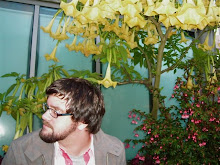
Last week I posted a couple pictures of an in-process project that involved making some display cases with spindles. Now that I've finished that project and caught up with (most) of my July work, I thought it would be both informative and cool to show some of the simple process for producing a spindle on a lathe. In doing so, I've omitted several pictures to get to the fun stuff (isn't that what we all want?). Check it:
Step 1) Cut a length of wood that is straight and square on the ends. If it isn't square when you start the lathe, you'll cause yourself irritation and potential eye injury trying to get it centered. If you've ever done ceramics, this process is very similar to centering the mound of clay on the wheel, except that if you don't do it right, you can't just remound the material - you'll waste an expensive piece of wood a tree died to give you. You might not think it, but the harder the wood, the easier it is too turn; soft wood chips and tears more easily, perhaps because the grain/wood fibers are not as tightly bound to one another. Generally, harder woods (maple, walnut, cherry) are much more expensive than softer woods (pine). Actually, come to think of it, perhaps leafy tree wood is softer than coniferous wood - something to think about at a later date... back to getting lathed:

When you have a length of wood that is square on both ends, mark an "X" through the center of both ends. You'll use these to center the piece on the lathe. If your "X" is off-center, you'll end up wasting a lot of material trying to make a cylinder, and probably split the wood or take off giant chunks as described above.
Step 2) Once you have the wood centered and attached to the lathe (again, there are steps here, but I'm trying to keep this relatively brief/simple), you attach your tool rest (a metal bar you place your chisel/knife against, which acts like a fulcrum) about 1/4" from the edge of the wood.
 (Step 3) For my project, I was cutting spindles, but wanted to keep the ends of each square, so I cut a very shallow groove around the perimeter of the wood, about 1 1/2" from each end (see photo). If I hadn't done this, I likely would have splintered off a chunk on each end; cutting the groove helps keep the ends square. If you're going to turn the entire length of wood, this wouldn't be necessary.
(Step 3) For my project, I was cutting spindles, but wanted to keep the ends of each square, so I cut a very shallow groove around the perimeter of the wood, about 1 1/2" from each end (see photo). If I hadn't done this, I likely would have splintered off a chunk on each end; cutting the groove helps keep the ends square. If you're going to turn the entire length of wood, this wouldn't be necessary.
Step 4) Next is the fun part - turning. Turn on the lathe (obviously). Place the tool firmly agains the tool rest and gradually move it toward the stock of wood, taking off bits/shavings of material very slowly. Proceed down the length of the material, cutting a little more with each pass, until you've turned a cylinder. Pretty easy, huh? It really is.
After that you can use all sorts of other chisels and knives with different ends to create different grooves and cuts in the spindle. For this project, I was given some general direction from the client, but they wanted each one to be different. This, combined with the "rustic" or "handmade" look they wanted, made the job incredibly easy. Typically I would sharpen my knives/chisels frequently, as well as sanding the piece with sandpaper from 60 or 80 grit all the way up to 600 grit or higher. I'd also wear a respirator, safety goggles and ear muffs (safety 1st!).
I should mention I've been doing this for a while now, but am nowhere near a pro. There are people who do this - and only this - type of woodworking as a passion, and produce some amazing things. With the exception of Christmas ornaments and baby rattles, turning is something I usually incorporate into a larger piece, rather than make as stand alone objects. If you want to see cool pictures of way better turnings, or learn more about the process, check out the Loess Hills Woodturners Club, a local club based out of Iowa. Of for more photos, check out the American Association of Woodturners.
I should mention I've been doing this for a while now, but am nowhere near a pro. There are people who do this - and only this - type of woodworking as a passion, and produce some amazing things. With the exception of Christmas ornaments and baby rattles, turning is something I usually incorporate into a larger piece, rather than make as stand alone objects. If you want to see cool pictures of way better turnings, or learn more about the process, check out the Loess Hills Woodturners Club, a local club based out of Iowa. Of for more photos, check out the American Association of Woodturners.





No comments:
Post a Comment